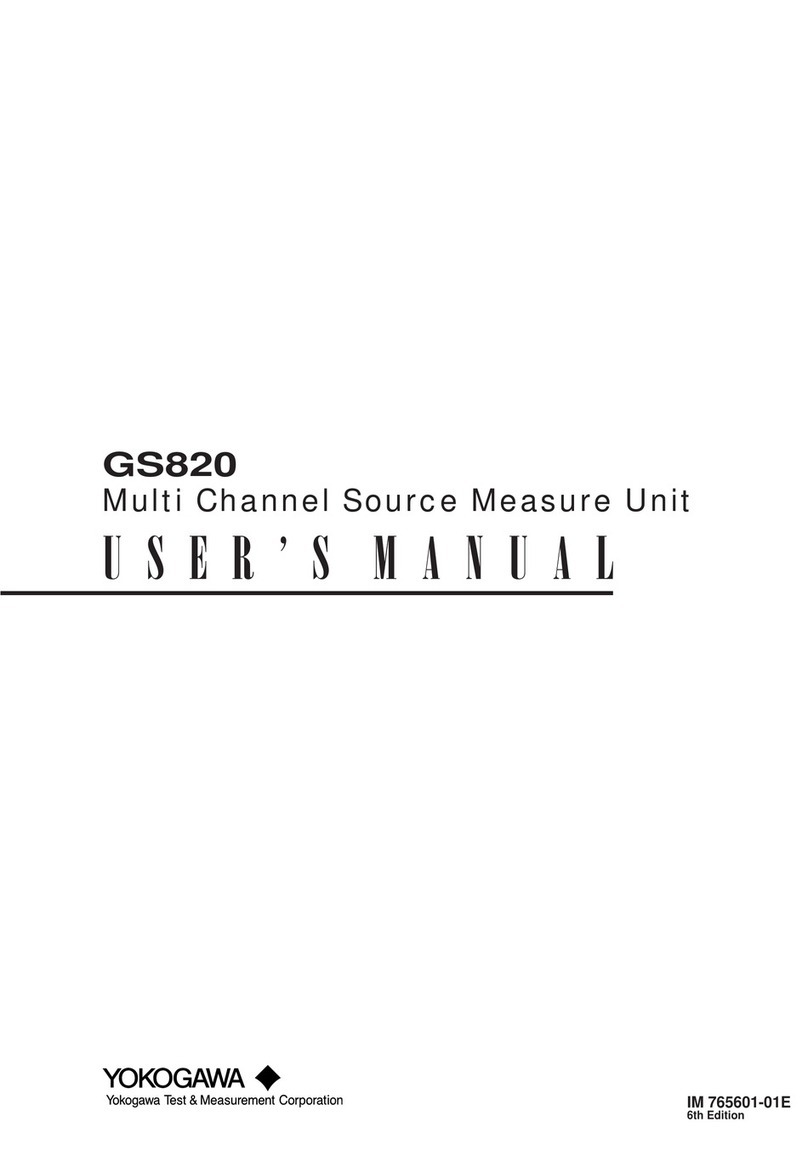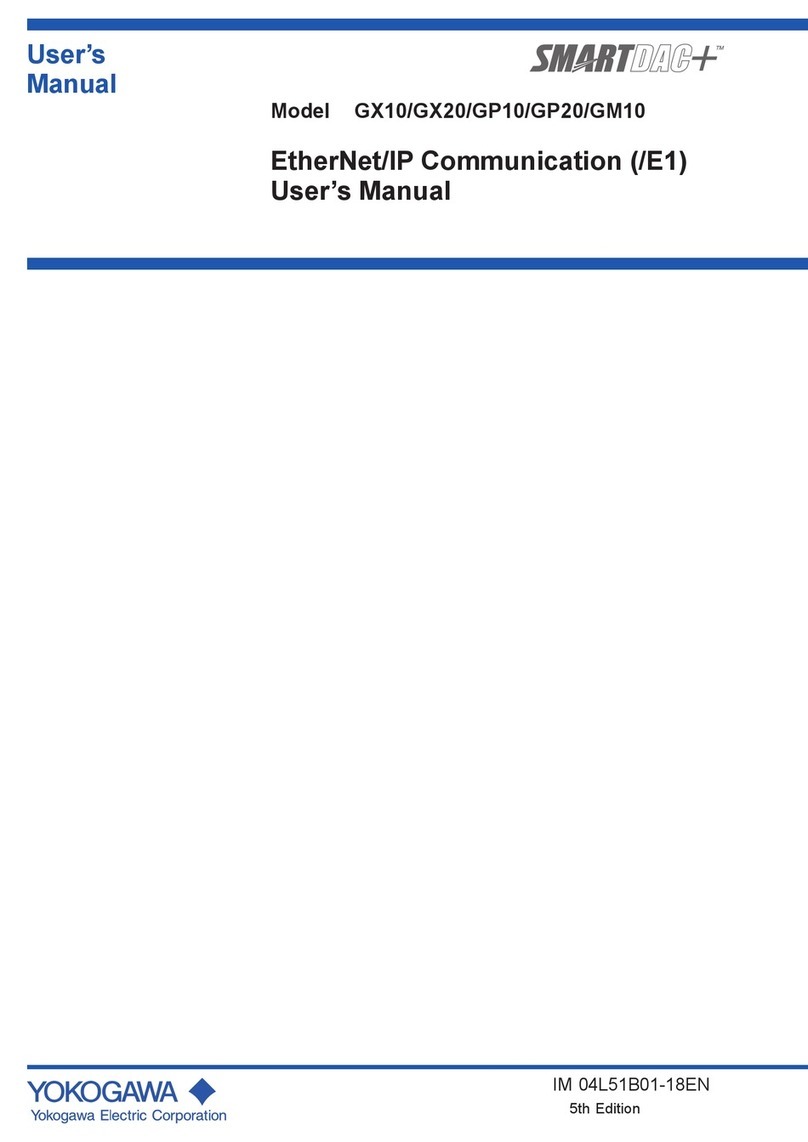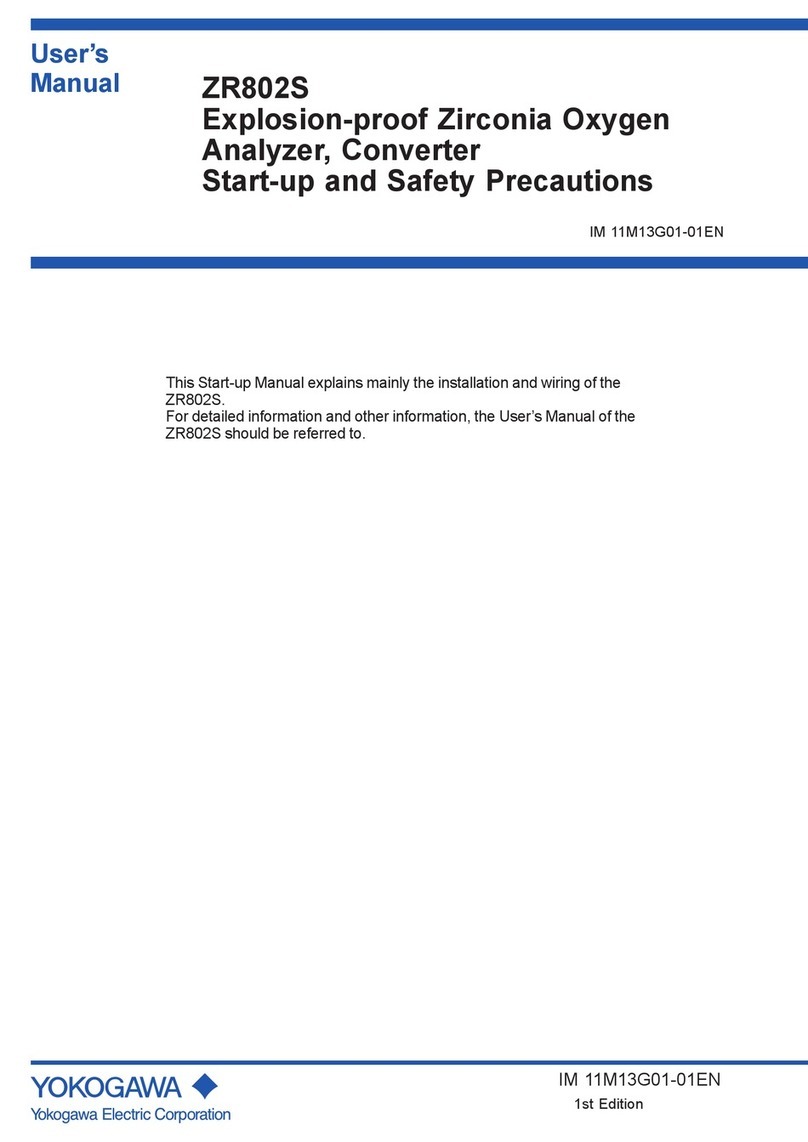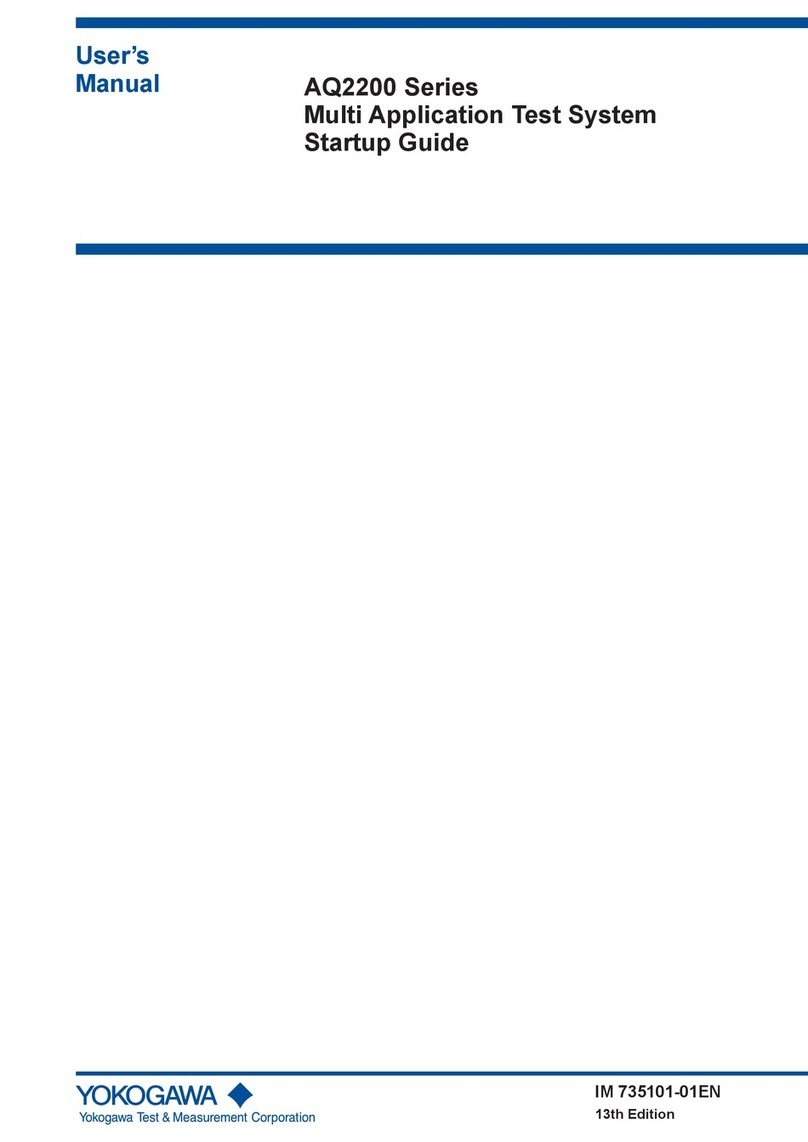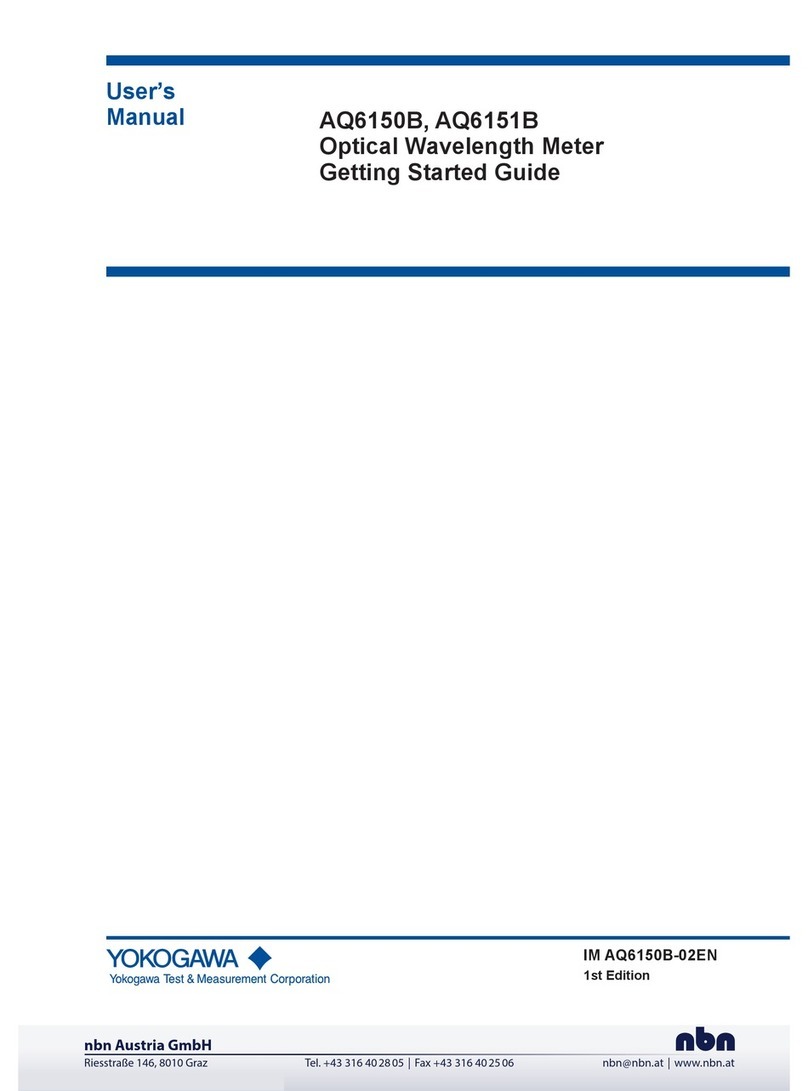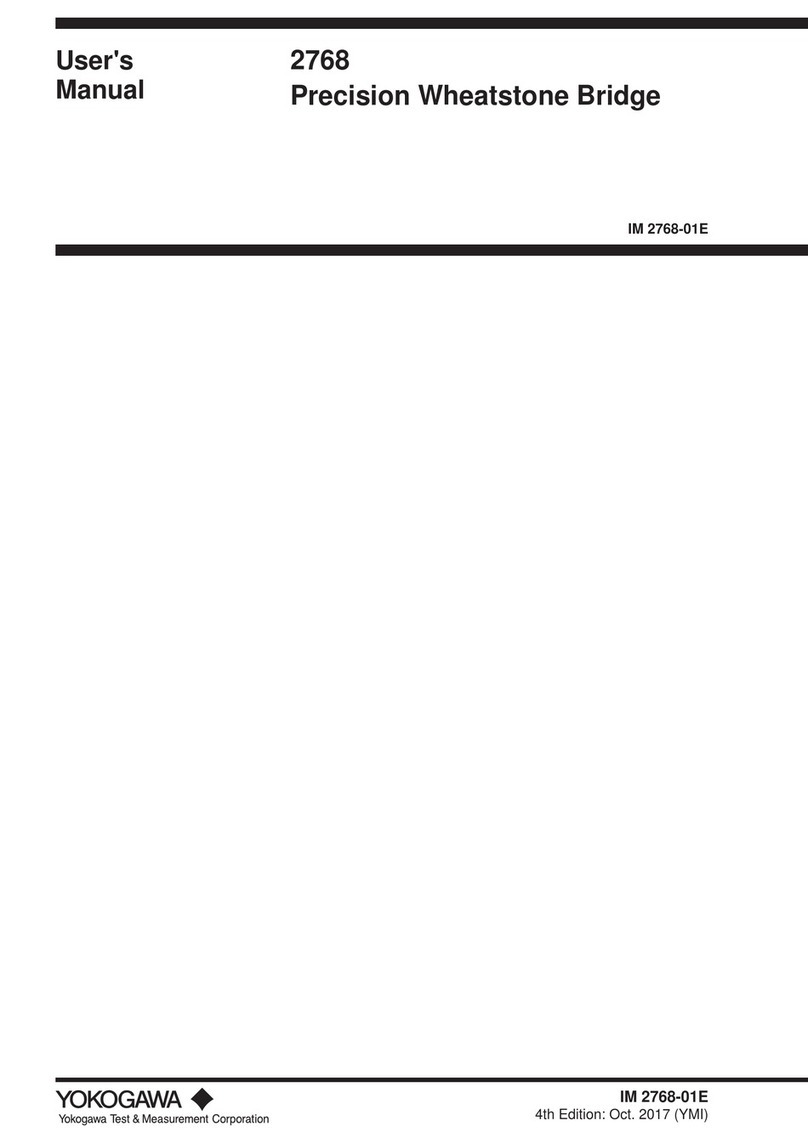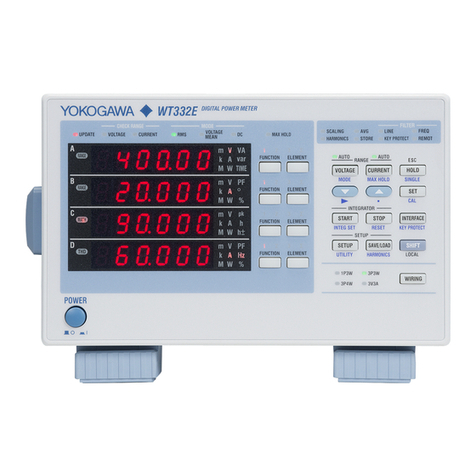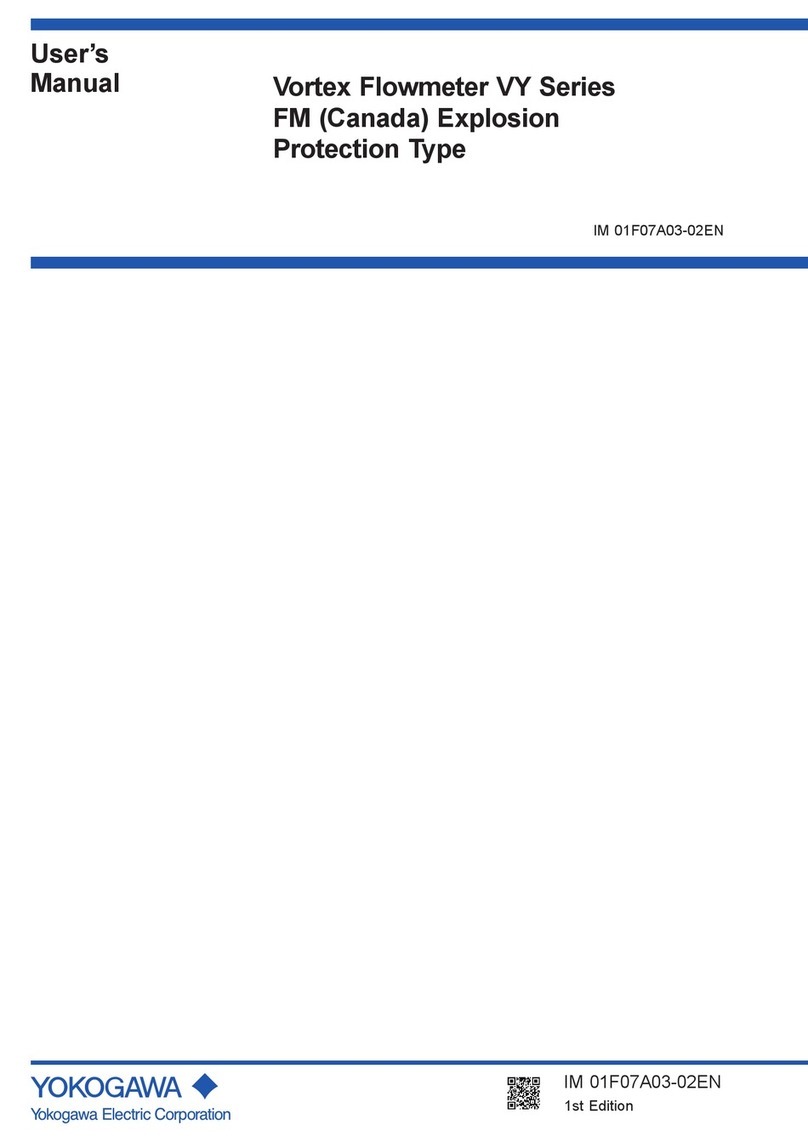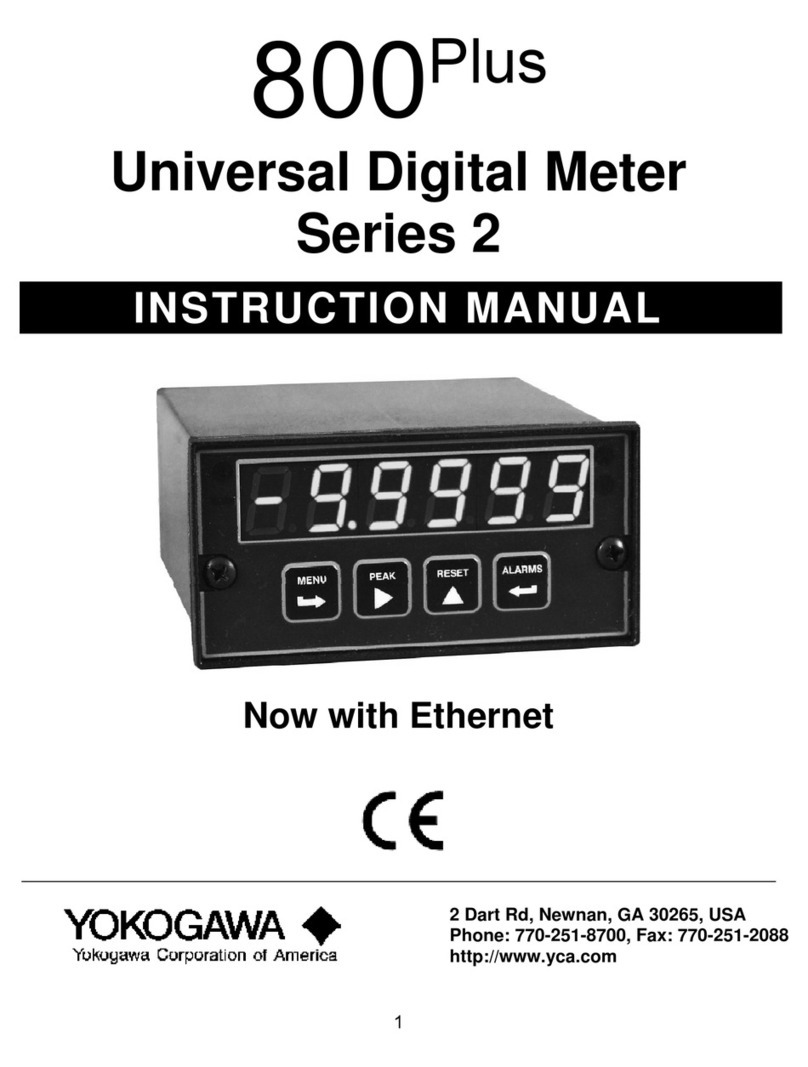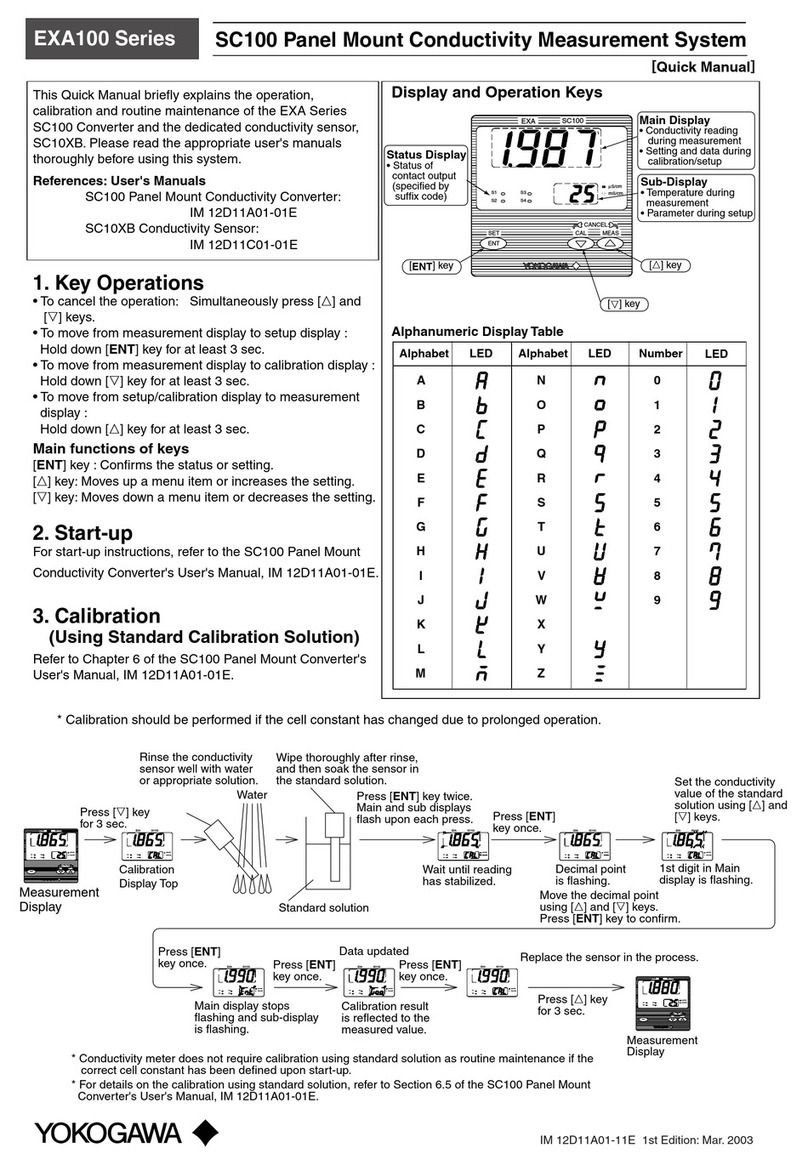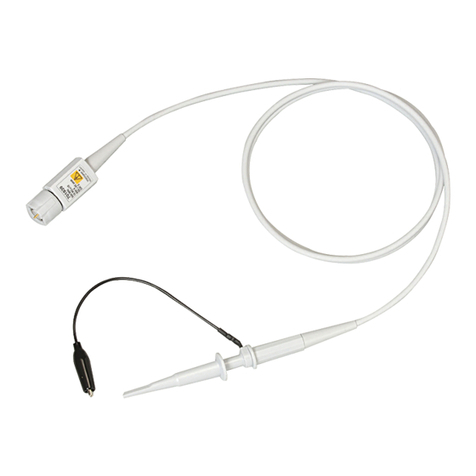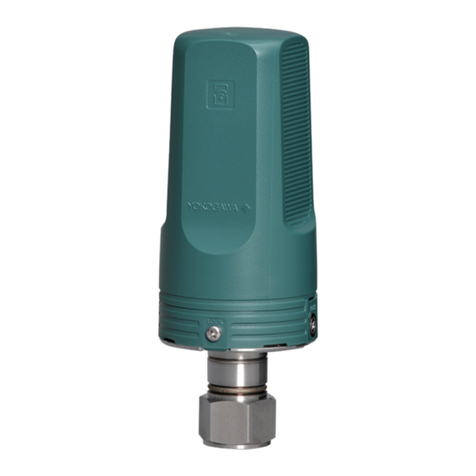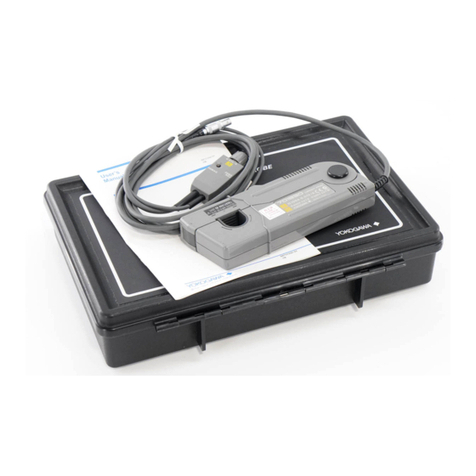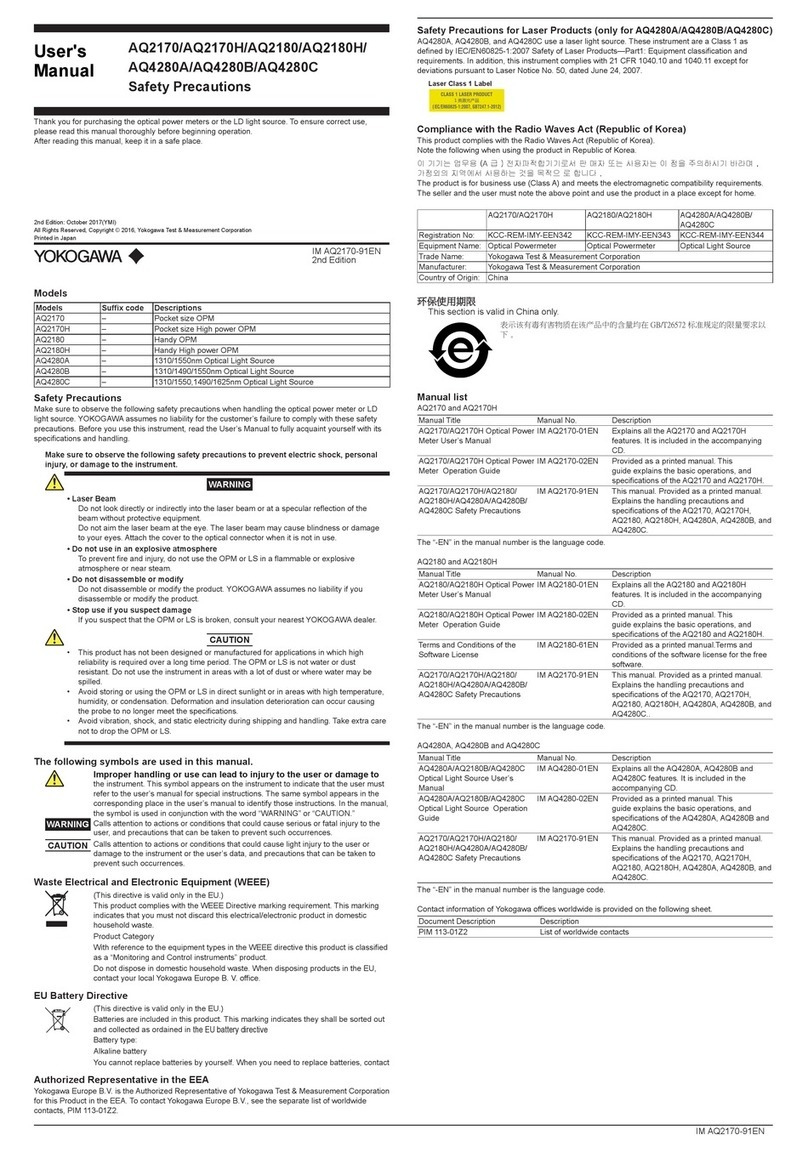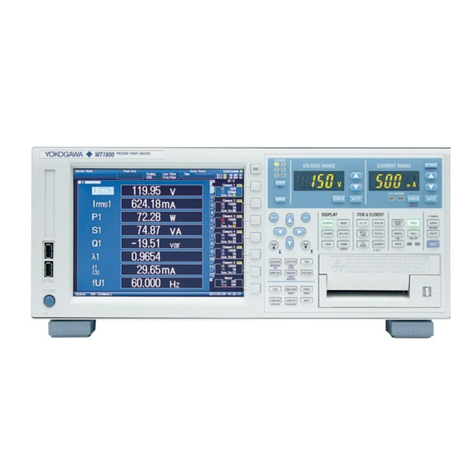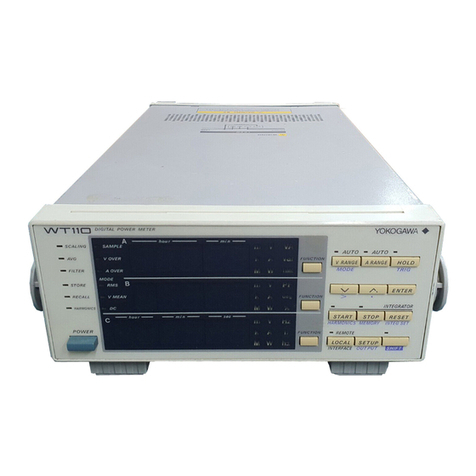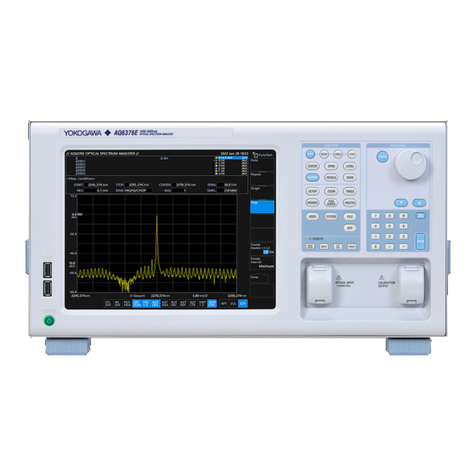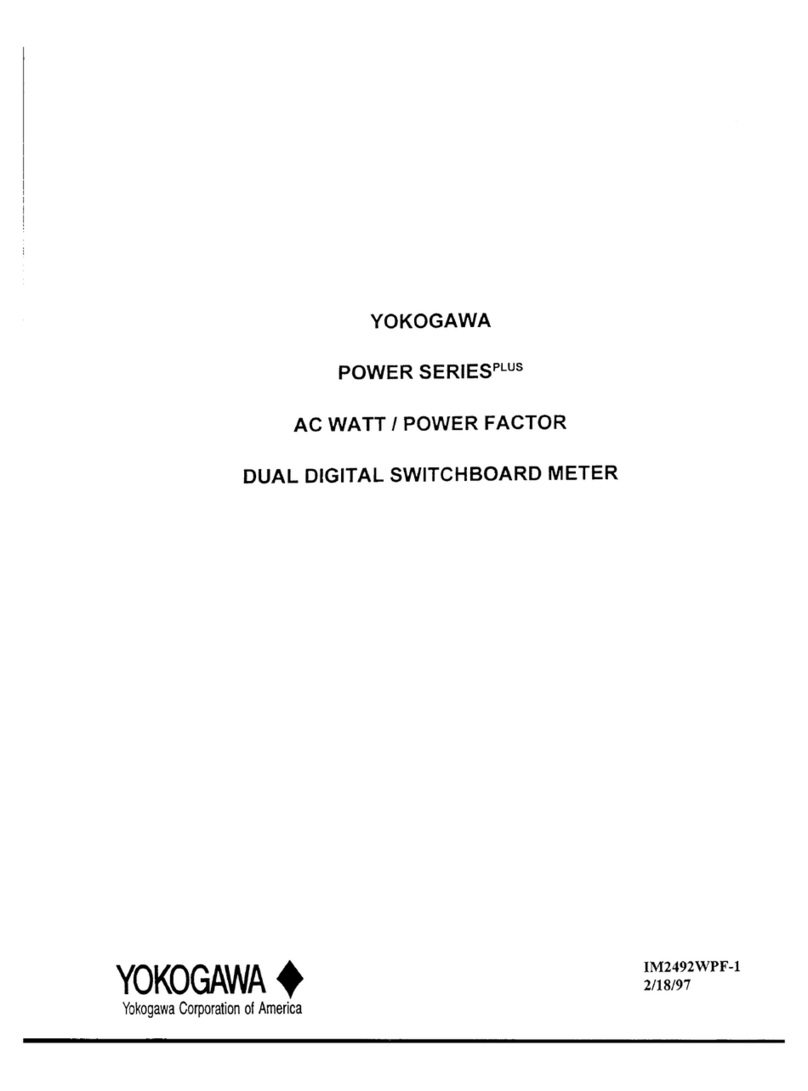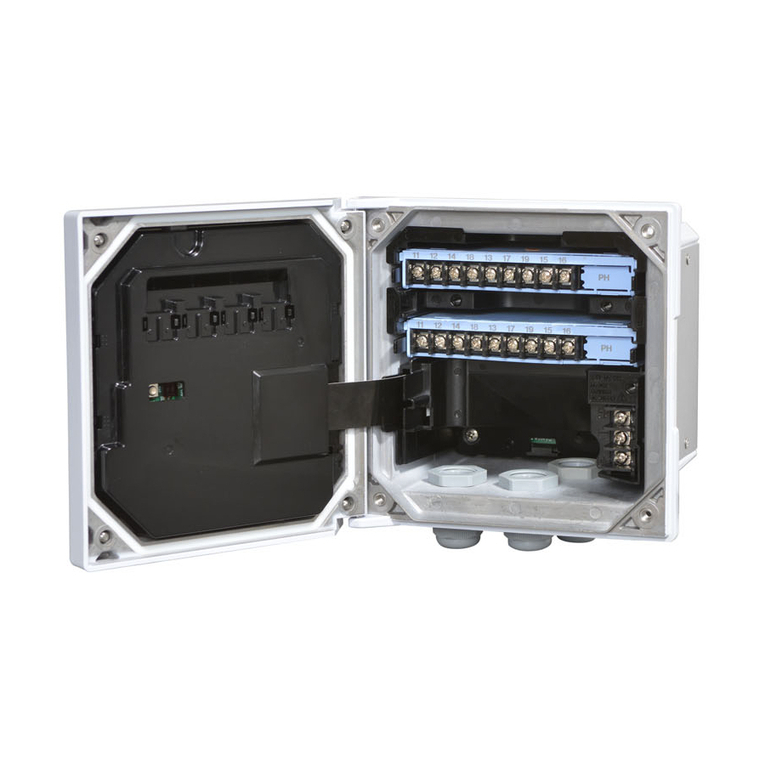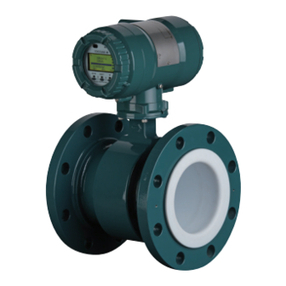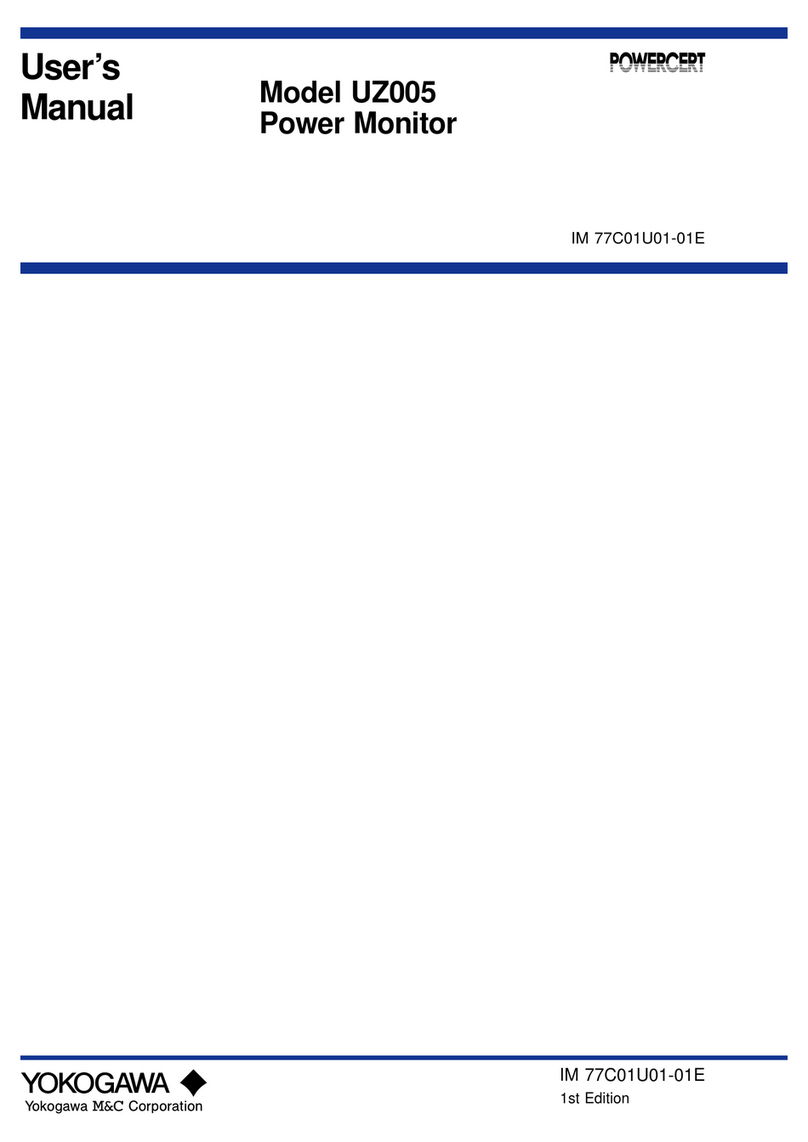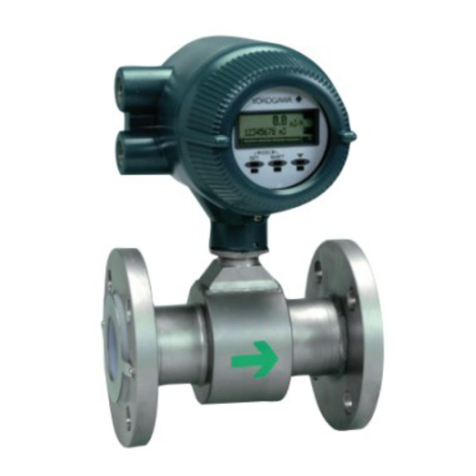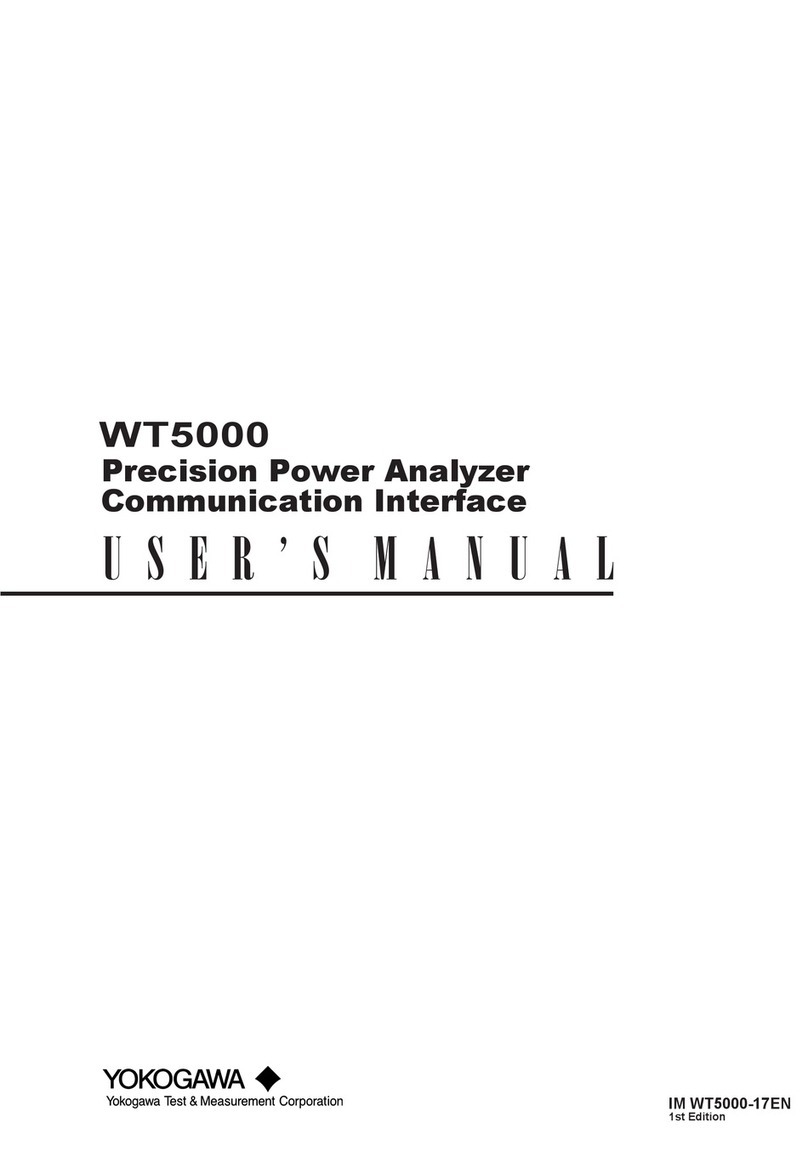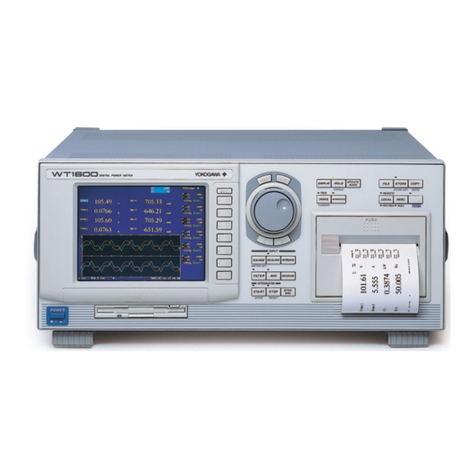
Checking the Package Contents
After receiving the product and opening the package, check the items described below. If the wrong
items have been delivered, if items are missing, or if there is a problem with the appearance of the
items, contact your nearest YOKOGAWA dealer.
Check that the product that you have received is the same product that you ordered.
For reference, the model name, suffix code, and specifications of the products are listed below.
Clamp-on Probe Accessories
Model Description Name Notes
96065 Clamp-on Probe 1000 A Cable marker 6 pieces (3 x 2): For 96065
96066 Clamp-on Probe 3000 A Output cable For 96066
Accessory is not covered by warranty of this instrument.
* For products whose suffix code contains “Z,” an exclusive manual may be included.
Please read it along with the standard manual.
Accessories (Manuals)
Manual No.
Notes
IM 96065-01EN This manual.
IM 96065-92Z1 A manual for China.
PIM 113-01Z2 Contact information of Yokogawa offices worldwide is provided.
* The clamp-on probe comes with the these manuals. Please keep them in a safe place.
The “-EN” in the manual number is the language code.
Safety Precautions
This product is designed to be used by a person with specialized knowledge.
The general safety precautions described herein must be observed during all phases of operation.
If the instrument is used in a manner not specified in this manual, the protection provided by the
instrument may be impaired.
YOKOGAWA assumes no liability for the customer’s failure to comply with these requirements.
This manual is an essential part of the product; keep it in a safe place for future reference.
The following symbols are used on this instrument.
Warning: handle with care. Refer to the user’s manual or service manual.
This symbol appears on dangerous locations on the instrument which require special
instructions for proper handling or use. The same symbol appears in the corresponding
place in the manual to identify those instructions.
Indicates a Instrument with double or reinforced insulation.
Indicates that application around and removal from UNINSULATED HAZARDOUS LIVE
conductors, which may render arc discharge, electric shock, or electric burn, is prohibited.
Indicates alternating current.
French
Avertissement: À manipuler délicatement. Toujours se reporter aux manuels d'utilisation
et d'entretien. Ce symbole a été apposé aux endroits dangereux de l'instrument pour
lesquels des consignes spéciales d'utilisation ou de manipulation ont été émises. Le
même symbole apparaît à l'endroit correspondant du manuel pour identifier les consignes
qui s'y rapportent.
Équipement protégé par une double isolation ou une isolation renforcée.
Ne pas enserrer ou retirer de conducteurs NON ISOLÉS sous TENSION DANGEREUSE
prouvant entrainer un choc électrique, une brûlure, ou un arc électrique
Indique courant alternatif.
Failure to comply with the precautions below could lead to injury or death or damage to the instrument.
WARNING
• This instrument is designed exclusively for the CW500 or the like products.
Do not use the instrument for devices other than the specified CW500 products.
• Do not use the instrument if there is a problem with its physical appearance.
• Never make measurement on a circuit in which the electrical potential exceeds
AC 600 V in the measurement category III using 96066.
• Never make measurement on a circuit in which the electrical potential exceeds
AC 300 V in the measurement category IV and AC 600 V in the measurement
category III using 96065.
• Do not operate the instrument in the presence of flammable gasses or vapors.
Doing so is extremely dangerous.
• Do not make measurement when thunder rumbling. If the instrument is in
use, stop the measurement immediately and remove the instrument from the
measured object.
• Do not use the instrument if the instrument or your hands are wet.
Otherwise, electrical shock accident may occur.
• Use insulated protective gears, such as insulated gloves, for your safety when
using this instrument.
• Only qualified YOKOGAWA personnel may remove the covers and disassemble
or alter the instrument.
•
Do not install or use the instrument outdoors or in locations subject to rain or water.
CAUTION
• Do not step on or pinch the cord to prevent the jacket of cord from being
damaged.
• The output connector shall be removed or connected without clamping a
conductor. Otherwise, it may cause a failure.
•
Do not expose the instrument to direct sunlight, high temperatures, humidity or dew.
•
Never give shocks, such as vibration or drop, which may damage the instrument.
This manual describes the safety precautions for using the clamp-on probe and the clamp-on
probe specifications. For details on its handling procedure, see the user’s manual of the measuring
instrument that the clamp-on probe will be used with.
5th Edition : March 2021 (YMI)
All Rights Reserved, Copyright © 2015, Yokogawa Test & Measurement Corporation
Printed in Japan
IM 96065-01EN
5th Edition
IM 96065-01EN
• Use a damp cloth and detergent for cleaning the instrument. Do not use
abrasives or solvents
• This clamp sensor is not designed to be dust or waterproof. Do not use it dusty
places or where the clamp sensor is likely to be wet. It may cause troubles on
the clamp sensor.
• Never pinch foreign matters or give vibrations at the jointed parts of this
clamp sensor. Otherwise, matching area of Jaws may be damaged and cause
influences on the measurements.
• Do not bend or pull the root of the cable in order to prevent breaks in the cable.
• Never apply the current exceeding the measuring range for a long time. It may
damage the clamp sensor.
• Never connect/remove the connectors while connected devices are on or
clamping onto the conductor under test. Otherwise, the connected devices or
clamp sensors may be damaged.
• Accurate measurement may not be obtained in the vicinity of strong magnetic
fields such as transformers, high-current circuits or wireless machines.
Operating Environment Limitations
The 96065 is classified as Class A (for use in industrial environments).
Operation of this product in a residential area may cause radio interference,
in which case the user will be required to correct the interference.
French
AVERTISSEMENT
• L’instrument est exclusivement concu pour les produits le CW500.
Ne pas utiliser l’instrument pour d’autres appareils que les produits CW500
indiques.
• Ne pas utiliser l'instrument si son intégrité physique semble être compromise.
• Ne jamais effectuer de mesure de l'intensité sur un circuit dans lequel le
potentiel électrique dépasse 600 V CA dans la catégorie de mesure III utilisant
96066.
• Ne jamais effectuer de mesure de l'intensité sur un circuit dans lequel le
potentiel électrique dépasse 300 V CA dans la catégorie de mesure IV et 600 V
CA dans la catégorie de mesure III utilisant 96065.
• Ne pas utiliser l'instrument en présence de gaz ou de vapeurs inflammables.
Cela pourrait être extrêmement dangereux.
• Ne pas effectuer de mesure lorsque le tonnerre gronde. Si l'instrument est en
cours d'utilisation, arrêter immédiatement la mesure et retirer l'instrument de
l'objet mesuré.
• Ne pas utiliser l'instrument s'il est mouillé ou si vos mains sont mouillées.
Sinon, un choc électrique peut se produire.
• Utiliser des équipements de protection isolés, tels que des gants isolés, pour
votre sécurité lors de l'utilisation de cet instrument.
• Seul le personnel YOKOGAWA qualifié est habilité à retirer le capot et à
démonter ou modifier l'instrument. Certains composants à l'intérieur de
l'instrument sont à haute tension et par conséquent, représentent un danger.
• Ne pas installer, ni utiliser l’instrument à l’extérieur ou dans des lieux exposés à
la pluie ou à l’eau.
ATTENTION
• Ne pas marcher sur le cordon et ne pas le pincer afin d'éviter que la gaine du
cordon ne soit endommagée.
• Le connecteur de sortie doit être retiré ou raccordé sans serrer un conducteur.
Si cette condition n'est pas respectée, cela risque de générer une défaillance.
• Ne pas exposer l'instrument aux rayons directs du soleil, à des températures
élevées, à l'humidité ou à la rosée.
• Ne jamais faire de chocs, tels que des vibrations ou des chutes, qui risqueraient
d'endommager l'instrument.
• Utiliser un chiffon humide et du détergent pour nettoyant l'instrument. Ne pas
utiliser de produits abrasifs ou de solvants.
• Ce capteur à serrer n'est pas conçu pour être recouvert de poussière et
n'est pas résistant à l'eau. Ne pas l'utiliser dans des endroits poussiéreux ou
dans des endroits où le capteur à serrer risque d'être mouillé. Cela risque de
perturber le fonctionnement du capteur à serrer.
• Ne jamais pincer de matières étrangères ou faire de vibrations au niveau des
pièces articulées de ce capteur à serrer. En effet, cela risquerait d'endommager
la zone correspondante des mâchoires et d'avoir des impacts sur les mesures.
• Ne pas plier ou tirer la base du câble afin d'éviter qu'il ne se casse.
• Ne jamais appliquer un intensité dépassant la plage de mesure pendant une
longue période. Cela risque d'endommager le capteur à serrer.
• Ne jamais raccorder ou retirer les connecteurs lorsque les appareils raccordés
sont allumés ou que le serrage sur le conducteur est en cours de test. En effet,
cela risquerait d'endommager les appareils reliés ou les capteurs à serrer.
• Il est impossible d'obtenir une mesure précise à proximité de champs
magnétiques puissants tels que des transformateurs, des circuits à haute
intensité ou des machines sans fil.
Limitations relatives à l'environnement opérationnel
Le 96065 est classé dans classe A (pour utilisation dans des environnements
industriels). L’utilisation de ce produit dans un zone résidentielle peut entraîner
une interférence radio que l’utilisateur sera tenu de rectifier.
Conventions Used in This Manual
The notes and cautions in this manual are categorized using the following symbols.
Improper handling or use can lead to injury to the user or damage to the instrument. This
symbol appears on the instrument to indicate that the user must refer to the user’s manual
for special instructions. The same symbol appears in the corresponding place in the user’s
manual to identify those instructions. In the manual, the symbol is used in conjunction with
the word “WARNING” or “CAUTION.”
Une manipulation ou une utilisation incorrectes risquent de blesser l’utilisateur ou
d’endommager l’instrument. Ce symbole apparaît sur l’instrument pour indiquer à
l’utilisateur qu’il doit se reporter au manuel de l’utilisateur afin d’y lire les instructions
spécifiques correspondantes. Ce même symbole apparaît à la section correspondante du
manuel de l’utilisateur pour signaler lesdites instructions. Dans le manuel de l’utilisateur,
ce symbole est accompagné des termes AVERTISSEMENT et ATTENTION.
WARNING
Calls attention to actions or conditions that could cause serious or fatal injury to the user,
and precautions that can be taken to prevent such occurrences.
AVERTISSEMENT
Attire l’attention sur des gestes ou des conditions susceptibles de provoquer des
blessures graves (voire mortelles), et sur les précautions de sécurité pouvant
prévenir de tels accidents.
CAUTION Describes precautions that should be observed to prevent minor or moderate injury,
or damage to the instrument.
ATTENTION Attire l’attention sur des gestes ou des conditions susceptibles de provoquer des
blessures légères ou d’endommager l’instrument ou les données de l’utilisateur,
et sur les précautions de sécurité susceptibles de prévenir de tels accidents.
Note Calls attention to information that is important for proper operation of the instrument.
96065, 96066
Clamp-on Probe
